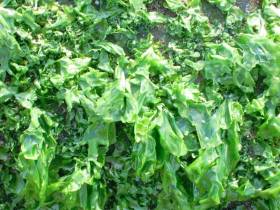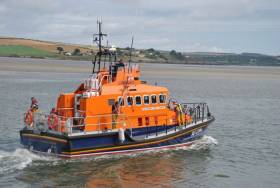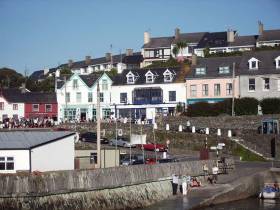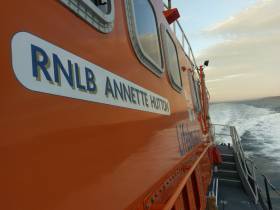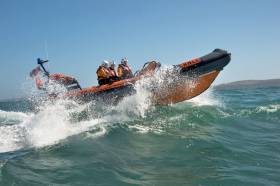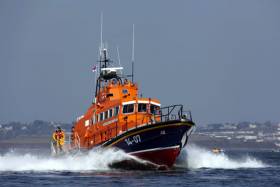Displaying items by tag: west cork
Baltimore Lifeboat In Medical Evacuation From Sherkin Island
#Lifeboats - Baltimore RNLI carried out a medevac on Thursday night (11 April) from Sherkin Island off the coast of West Cork.
The volunteer crew launched their all-weather lifeboat following a request from the Irish Coast Guard at 9.29pm to provide medical assistance and evacuation to an islander living on Sherkin.
Conditions at sea during the callout were calm with good visibility and no sea swell.
The lifeboat arrived at Sherkin pier at 9.45pm, the casualty was brought onboard and the lifeboat departed the island within four minutes, handing the casualty over to the care of HSE ambulance crew at 10.08pm.
Speaking following the callout, Kate Callanan, Baltimore RNLI volunteer lifeboat press officer, said: “Baltimore RNLI regularly provides the vital service of medical evacuations (medevacs) for residents and visitors to local islands such as Sherkin, Cape Clear and Heir.
“If you find yourself in need of medical assistance, call 999 or 112 and ask for the coastguard.”
Elsewhere, volunteer lifeboat crews from the Aran Islands and Galway RNLI participated in a multi-agency training exercise on Galway Bay this week.
The all-weather lifeboat from Aran Islands RNLI and the inshore lifeboat from Galway Bay RNLI were among the many emergency service agencies that took part in a maritime mass rescue exercise.
The scenario training, which saw the lifeboat crew practise an evacuation of survivors from a seagoing ferry in a busy shipping lane, was organised as part of a multi-agency exercise co-ordinated by the Irish Coast Guard.
Among the other agencies involved were the Irish Coast Guard rescue helicopters located at Sligo and Shannon, Doolin/Inisheer Boat Unit, Costello Bay, Killaloe, Kilkee and Cleggan Coast Guard units, Galway Fire Service and the HSE.
Nitrates and phosphates from intensified agriculture are a significant cause of so-called green and red tides in West Cork, according to a new report.
Dr Liam Morrison, one of the researchers behind the NUI Galway study, tells the Southern Star that more must be done to keep farm nutrients from flowing out to coastal areas where they feed the growth of red and green seaweed or sea lettuce blooms.
While these blooms currently pose no heath risk to humans, the report alleges that they cause issues for inshore navigation, sea angling and ultimately tourism.
However, the Irish Farmers’ Association says agriculture cannot be solely to blame — citing a reduction in seaweed blooms in areas where wastewater treatment schemes have been upgraded.
The Southern Star has more on the story HERE.
Whale & Dolphin Strandings In Cork This Week ‘Only A Percentage Of What Is Actually Dead At Sea’
#MarineWildlife - Unusual weather for this time of year may be responsible for a recent spate of whale and dolphin strandings on the Cork coast in the past week.
The Irish Examiner reports that among the eight strandings were the carcass of a sperm whale on Long Strand in West Cork and a dolphin with fishing line around its beak in Schull.
However, the Irish Whale and Dolphin Group’s (IWDG) Mick O’Connell said that while the statistic was high within such a short timeframe, it was not necessarily a mystery.
“We normally get the same thing every year,” said the IWDG stranding officer. “It is usually more in the southwest and west, but this year, I suppose we have had more southeast winds, which probably explains it.”
O’Connell added that the strandings are “only a percentage of what is actually dead at sea” — and that post-mortems may “shed some light in their deaths”.
The Irish Examiner has more on the story HERE.
Kinsale Yacht Club Objects To Mussel Farming Licence
Kinsale Yacht Club is encouraging its members to make submissions on the recent licence application for a mussel farm off Castlepark Beach in the West Cork harbour.
Following its previous trial in the area, Woodstown Bay Shellfish — based in Dunmore East, Co Waterford — made its application late last year for an Aquaculture Licence to dredge for mussels at a site of around 25 hectares beyond James Fort.
The application also states that the site is located in or adjacent to a sensitive area, the closest to the site being the Sovereign Islands Special Protection Area.
A public notice was published in the Southern Star last Thursday 7 February, and submissions must be made prior to Wednesday 6 March quoting the reference T05/472A to:
Department of Agriculture Food and the Marine
Aquaculture and Foreshore Management Division
National Seafood Centre
Clonakilty, Co Cork
All submissions must be signed and no fee is required.
Kinsale Yacht Club Commodore David O’Sullivan confirmed that the club has already made its own submission on behalf of KYC members, which is available on the club’s website.
The letter cites the strong tidal current in the proposed location of the mussel bed as a concern – and suggests a recent "notable increase" in mussel growth in the marina, allegedly resulting from mussels from the trial being washed towards the town after stormy conditions.
“We must do all we can to preserve our beautiful harbour and every little helps,” Cdre O’Sullivan said.
Courtmacsherry Lifeboat Rescues Fishing Vessel With Two Onboard
#Lifeboats - The RNLI's all-weather lifeboat from Courtmacsherry rescued a fishing vessel which got into difficulty today with two people onboard yesterday afternoon (Monday 21 January).
The lifeboat was called out at 1.15pm to go to the aid of the 40ft vessel which had got into difficulties off the Seven Heads peninsula in West Cork and required assistance.
Under coxswain Sean O'Farrell and a crew of six, the lifeboat was quickly away and made its way at full speed to the area of the casualty.
Conditions at sea were fresh, with winds blowing Force 6 as the cold snap of weather finally hit the South Coast.
The lifeboat reached the casualty at 1.45pm and immediately took the boat, which had two crew members, in tow.
After a slow tow in lumpy conditions, the lifeboat and the casualty arrived to the safe surrounds of the Courtmacsherry Pontoon at 3.15pm.
This is the second callout so far of 2019 and voluntary lifeboat operations manager Brian O’Dwyer praised all the crew who responded so quickly today on a cold January Monday.
The crew on yesterday’s callout were coxswain Sean O’Farrell, mechanic Stuart Russell and crew members Mark Gannon, Dara Gannon, Ken Cashman, Austin McKenna and Evin O’Sullivan.
Brian further commented that there were four more crew that turned up quickly: “I am really proud that 11 crew members reacted swiftly today in the help of local fishermen who required assistance at sea.”
Baltimore Sailing Club Announces High Performance Fund
Baltimore Sailing Club in West Cork is now seeking expressions of interest from suitably qualified applicants for its High Performance Fund.
Details of guidelines for the Olympic Pathway support fund and the application form can be downloaded from the Baltimore Sailing Club website HERE.
The closing date for applications is Friday 21 December.
#Lifeboats - Castletownbere’s all-weather lifeboat launched last night (Wednesday 10 October) to a Mayday from six fisherman whose boat lost power and was drifting rapidly towards the shore.
Pagers sounded for the volunteer RNLI crew at 7.30pm following the alert to the Irish Coast Guard from the 25m fishing boat, which had fouled its propeller at the entrance to the West Cork harbour.
With time of the essence, coxswain Dean Hegarty and his four crew launched immediately and the lifeboat was on scene within five minutes, at which point the vessel was just 20 metres from the shore.
The boat had been blown into a small area by Pipers Rock at the harbour mouth in south-westerly Force 8-9 gales and amid a 4-5m swell.
The lifeboat crew worked quickly to set up a towline and rescue the boat and her crew from immediate danger before bringing them safely back to Castletownbere.
“Given the weather conditions and how close the fishing boat was drifting to the shore at this point, the lifeboat’s timely arrival managed to avert a potential tragedy,” said Paul Stevens, Castletownbere RNLI lifeboat operations manager.
“The fishermen did the right thing in raising the alarm when they did and we would like to wish them well following what must have been a challenging experience.”
Baltimore Lifeboat Launches To Speedboat With Engine Troubles
#RNLI - Baltimore RNLI was called out last night (Tuesday 4 September) to a speedboat with engine trouble near Bird Island in West Cork.
The volunteer lifeboat crew were on exercise in their inshore lifeboat when the request came in from the Irish Coast Guard at 7.55pm to assist the 17ft speedboat, with four people onboard and reporting to have engine trouble north of the island near Cape Clear.
The lifeboat, with three volunteer crew onboard — helm John Kearney, John McDonough and Colin Rochford — was already in the vicinity of Cape Clear when the call came in and reached the casualty vessel at 7.57pm.
Conditions at the time were calm with a northerly Force 2-3 wind and slight sea swell.
When the lifeboat crew arrived on scene, the speedboat was only 100m north of Bird Island and was drifting towards the shore in calm seas, but in an area known for its strong tides.
The lifeboat immediately secured a tow line to the bow of the speedboat and, after confirming all onboard were okay, they towed the vessel to Baltimore harbour.
In other news, Baltimore RNLI’s annual barbecue will be hosted by Derry and Sally Anne Clarke at Sherkin House on Sherkin Island from 1pm this Saturday 8 September. All are welcome and no booking is required.
#RNLI - Courtmacsherry RNLI’s all-weather lifeboat Frederick Storey Cockburn was called out at 9pm on Friday night (3 August) to go to the aid of a 36ft yacht adrift some 18 miles off the Old Head of Kinsale in West Cork.
Under coxswain Sean O’Farrell and a crew of six, the lifeboat was underway within minutes, travelling at its top speed of 25 knots, and located the vessel at 10.30pm.
The yacht had been on passage from the Isle of Wight when it lost power and its crew sent out a distress message to the Irish Coast Guard.
The lifeboat immediately attached a tow rope to the casualty and proceeded to tow the yacht, which had four crew onboard, slowly and safely back to Courtmacsherry Harbour.
Friday night’s callout was the first to use the Courtmacsherry station’s early warning message Siren, which will now be part of every callout in order to alert people in the water nearby or the public in the village that a lifeboat call is in progress.
Lifeboat operations manager Brian O’Dwyer said: “It’s been the busiest six weeks for many a year and many thanks to all the volunteers at the station for always putting the rescue of others ahead of all their other interests.”
The busy time continued over the August Bank Holiday weekend as the Courtmacsherry lifeboat was called at 12.20pm n Saturday afternoon (4 August) to a pleasure cruiser in difficulty off the Seven Heads peninsula.
The casualty boat, with three on board, had fouled its propellers and lost power while on passage to Castletownshend, having departed Crosshaven the previous day.
Once again under coxswain Sean O’Farrell, the lifeboat towed the stricken vessel back to the safe surrounds of the Courtmacsherry Pier Pontoon.
#FerryNews - A new fast ferry has just been commissioned for Cape Clear Island Ferries after completing various surveys and sea trials and a number of modifications to comply with Irish MSO standards.
Dún na Séad II was purchased in Norway earlier this year and arrived in Baltimore in April. It is capable of speeds of up to 20 knots with an operating speed of 18 knots and has a crane and cargo capacity of 6 tons.
Features include airline-style seating with large windows in a comfortable saloon with air conditioning and other features.
Licensed for 97 passengers with upper deck seating that affords outstanding 360-degree views of Roaringwater Bay, the ferry marks a substantial investment for the Cape Clear Island Ferries which owns three other passenger vessels: Dún an Óir II, Dún Aengus and Cailín Óir.
Dún na Séad II will operate primarily on the Schull—Cape Clear route but it is planned to use her occasionally on the Baltimore—Cape Clear route which is the main year-round service to the island.
Current traveling times of 45 minutes from both Schull and Baltimore will be halved when this vessel is in use.
Cape Clear Island Ferries says that the larger vessel together with the shorter journey time more than doubles the potential passenger capacity, and its focus will be on larger groups, bus and coach tours as well as building relationships with complementary service providers.
The ferry company has in recent years focused on soft adventure tourism surrounding the Fastnet Rock Lighthouse, which has shown double-digit growth over the past four years.
Considered the ‘Gateway to the Fastnet’, Cape Clear Island regularly welcomes passengers arriving from both Schull and Baltimore to see the famous rock.
While the company does not offer specific whale-watching trips, whale and dolphin sightings are a frequent occurrence in the area.
Cape Clear Ferries is owned by local shareholders on Cape Clear Island and Baltimore and its management, shareholders and staff are all from the immediate area. The business was established in 2007.




























